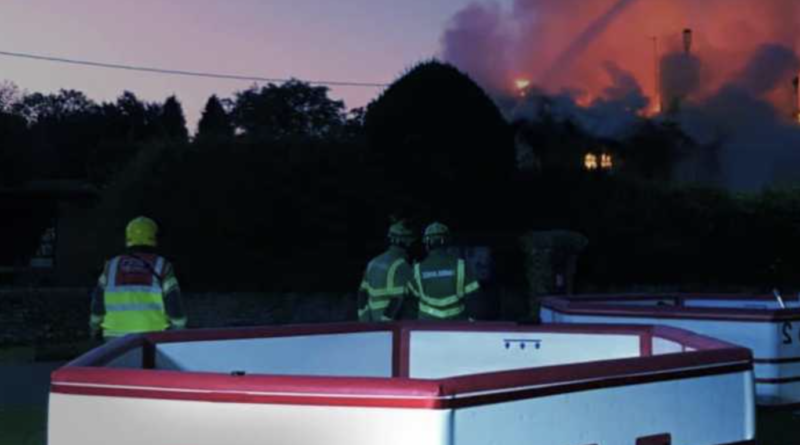How do Inflatable Structures Protect Against Fire
Inflatable structures have long been used as temporary shelters in a variety of settings, including disaster relief efforts. In recent years, inflatable shelters have also been used as a way to protect against fire.
Material Make Up of Inflatable Structures:
These structures are made from various materials, including PVC, nylon, and polyester, which are all highly flame-resistant.
When an inflatable structure is inflated, it creates a barrier between the shelter and the outside world. This barrier helps to prevent the spread of fire.
In addition to their flame-resistant properties, inflatable arrangements are also very sturdy. They can withstand high winds and heavy rains. This makes them ideal for use in emergency situations.
Inflatable structures are a safe and effective way to protect against fire. They are also easy to set up and take down. This makes them an ideal choice for use in a variety of settings.
When it comes to fire safety, inflatable structures can be a valuable asset. While they are often thought of as toys or temporary shelters, they can also be used to protect against fire.
Use of Inflatable Structures:
When filled with air and water, inflatable structures can act as a barrier between a fire and the area that needs to be protected. They are relatively light and easy to transport, making them ideal for use in emergency situations.
Firefighters often use these structures to create firebreaks, which can help to contain a fire and prevent it from spreading.
In addition, they can be used to protect buildings and other structures from fire damage by creating a barrier between the fire and the structure, inflatable structures can help to minimize damage and prevent the fire from spreading. As a result, inflatable structures can be an effective tool for protecting against fire.
Different inflatable products used by Fire & Rescue services
ACETYLENE ISOLATOR
There are many different types of safety equipment that you can find in industrial and commercial settings, but an acetylene isolator is one unique piece. This device prevents the user from being exposed to high levels of toxic gas if they happen upon a mistake or spill while working with this material.
Whenever gas is used, an isolator must be installed to prevent accidental ignition. The two-chambered device consists of valves that separate and seal off each chamber before admitting its respective compressed air source for safekeeping oxygen out until needed again.
The chamber containing the acetylene is filled with inert gas, such as nitrogen, which prevents the gas from igniting. To prevent overfilling and to signal when the panels are full of water, all of them are equipped with pressure relief valves. In the event of a leak, the valves will close automatically, preventing the escape of gas. Acetylene isolators are an important piece of safety equipment for any business that uses acetylene.
In 2008, the device was put through its paces at the Royal College of Science test facility in Wiltshire, England, where acetylene bottles were heated until they burst within a typical Waterwall unit.
FIREMOTE ISOLATION UNIT
A firemote isolation unit is a specialized device that is used to isolate fire from the surrounding area. The unit consists of a stand-alone fire fighting robot coupled with a blast mitigation product known as Waterwall.
This robotic vehicle is small enough to fit through small openings, such as homes or small workshops, climb thresholds and steps, and operate around obstacles. The robot can use an adjustable arm that can be elevated and moved remotely to target the source of the fire with the help of a camera and/or thermal imager.
Water enters the robot at the back and travels through the body toward the front-facing movable arm. A valve that produces a variety of spray effects to extinguish fires is attached to the end of the arm and is electronically controlled.
Once the fire has been extinguished, the robot can investigate the area for any potentially lethal acetylene gas bottles that may have been present or nearby, as well as any other potential industrial dangers.
HEXAGON WATER DAMS
Hexagon water storage dams are designed to easily store and rapidly erect strategic reservoirs for fire-fighting operations.
They are made up of hexagonal cells that are stacked on top of each other and filled with water. Hexagon shapes help to increase the storage capacity of the reservoir by allowing more water to be stored in a smaller space.
They are often used in areas where space is limited, such as in cities or near mountain ranges. They can also be used to help prevent flooding by controlling the release of water from the reservoir.
This storage unit allows a tanker or bowser to fill up and leave, while the fire appliance can draw water from the storage unit.
FLOOD DEFENCE
Flood defence units consist of a modular system of ‘A’ frames which are inflated with air and positioned next to each other across the low-lying area. The individual ‘A’ wall sections come flat packed in a valise and are quickly inflated to the desired shape using an air pump.
Once the walls have been built, they are connected to create a wall that resembles a castle defence.
Additionally, the structure can be placed completely around a building or structure to create a dry area using the shaped corner units.
After being put into place, each unit is separately pumped with water, which pushes out the air through relief valves and creates a sturdy structure that can sustain water pressure up to 1.5 metres in height. The interior triangle section can also be filled with air or water to enhance strength and support if that is necessary.
On top of “T”-shaped construction barriers, the construction joints are waterproofed using PVC flaps bonded to the Waterwalls using velcro strips at both sides and the base of each unit.
Conclusion
The use of inflatable structures to protect people and property from fire is a relatively new concept, but it has already been proven to be an effective tool.
In the past, inflatable structures have primarily been used in military applications, but their potential for civilian use is just now being explored. There are many benefits to using these kinds of structures in place of traditional construction materials in the event of a fire. They are lightweight and easy to transport, can be erected quickly, and provide superior protection against heat and flames.
In addition, because they are made of plastic or other non-flammable materials, there is little risk of them igniting during a fire.
Firemen around the world are beginning to see the value of these inflatable structures.



